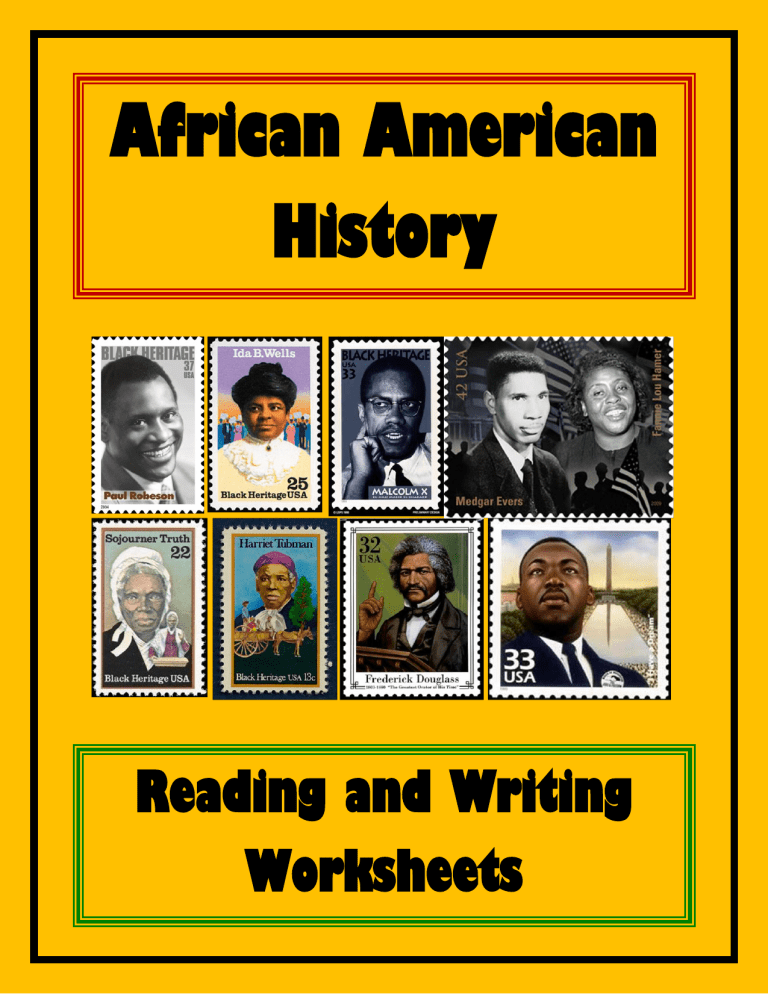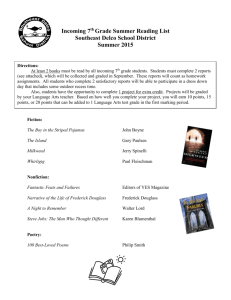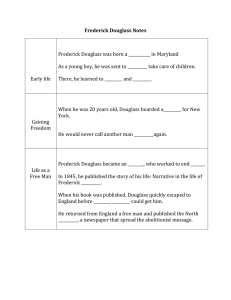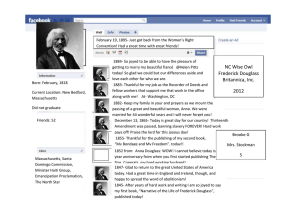African American History: Frederick Douglass Worksheet Packet
advertisement

African American History Reading and Writing Worksheets This Worksheet Packet Was Created by The Worksheet Guy Download the Worksheet Bundle / Workbook and save $20!!! Over 300 pages of African-American History!!! https://www.teacherspayteachers.com/Product/Elementary-African-American-HistoryWorksheet-Bundle-Workbook-2095917 Visit my store to see my vast array of materials for grades 1-12!!!!! https://www.teacherspayteachers.com/Store/The-Worksheet-Guy Follow me on Pinterest – access over 40 of my FREE products and learn about my new ones!!! http://www.pinterest.com/worksheetguy/common-core-explosion/ Name __________________________________________ Date ________________________ Frederick Douglass Born into slavery, Frederick Douglass escaped when he was about twenty years old. Douglass wrote a famous autobiography describing the horrors of slavery and the joys of liberty. He worked on the Underground Railroad and became a great and famous public speaker. Douglass argued passionately all his life for the abolition of slavery. He also took up the cause of women’s rights. Early Life Frederick Augustus Washington Bailey was born about 1817 in Maryland. He was never sure of the date of his own birth. “Genealogical trees did not flourish among slaves,” he dryly commented in his autobiography. “I never met with a slave in that part of the country who could tell me with any certainty how old he was. Few at that time knew anything of the months of the year or of the days of the month.” Frederick’s mother was a slave named Harriet Bailey. He never knew who his father was. Most people believed that Harriet Bailey’s white owner was Frederick’s father. When a young and strong female slave bore a child, it was often taken away from her so that she could return to work and give her full energy to her chores. Another black woman on the plantation, one too old to do much heavy work, would raise and care for the baby. Frederick was given to his grandmother, Betsy Bailey. He only saw his mother a few times during his childhood. She died when he was seven. Frederick was very happy living with his grandmother, but was taken away from her as soon as he was old enough to work. He was only seven when his master sent him to Baltimore to live with and work for a family named Auld. Sophia Auld was kind to the child. She taught him to read. She was proud of his progress and mentioned it to her husband, who scolded her for what she had done. “If he learns to read the Bible it will forever unfit him to be a slave,” Auld blustered. “He should know nothing but the will of his master, and learn to obey it.” The reading lessons ceased. However, Frederick continued to practice reading and writing in secret. As he grew older, he would teach other slaves to read and write. Name __________________________________________ Date ________________________ At Covey’s Farm Frederick first learned of a movement to abolish slavery when he read about Congressman John Quincy Adams in a newspaper. Adams had often presented antislavery bills in Congress. Frederick could hardly believe that there were white people who urged that slavery be abolished. He soon determined to run away and gain his freedom. During the 1830s, Frederick worked for Hugh Auld’s brother, Thomas. He intended to make the rebellious young man accept slavery as his lot in life. He sent him to live with and work for a man named Edward Covey. Local blacks greatly feared and hated Covey. He was known to be merciless and cruel toward slaves. Frederick summed up his experience at Covey’s farm as follows: I was made to drink the bitterest dregs of slavery . . . during the first six months of my stay with this man Covey. We were worked all weathers. It was never too hot, or too cold; it could never rain, blow, snow, or hail too hard for us to work in the field. Work, work, work, was scarcely more the order of the day than of the night. The longest days were too short for him, and the shortest nights were too long for him. . . . Mr. Covey succeeded in breaking me—in body, soul, and spirit. My natural elasticity was crushed; my intellect languished; the disposition to read departed, the cheerful spark that lingered about my eye died out; the dark night of slavery closed in upon me, and behold a man transformed to a brute! One day, after one of many beatings, Frederick had had enough. He fought back. Covey was astonished and frightened at being struck by a slave. Frederick remained at Covey’s farm for another six months. Covey never punished him again. Escape from Slavery After his time at Covey’s farm, Frederick decided to lose no more time before he ran away. A first attempted escape failed. Frederick did not give up. He borrowed identification papers from a free black sailor and boldly and openly boarded a train for New York. He dressed like a sailor for the journey, in a red shirt, with a kerchief knotted loosely around his neck. “My knowledge of ships and sailor’s talk came much to my assistance,” he wrote later. “I knew a ship from stem to stern, and from keelson to cross-trees, and could talk sailor like an ‘old salt.’ ” Thus disguised, he hoped to fool any suspicious officials. When the train conductor came by to collect tickets and check the black passengers’ identification papers, Frederick knew that his entire plan might fail. The conductor might notice that the passenger before him did not match the description given on the papers. But Frederick was lucky. The conductor gave the papers only a quick glance and was satisfied. When the train arrived at the last station, Frederick was free. He never again worked as a slave. He wrote later of his first feelings at being a free man: Name __________________________________________ Date ________________________ I found employment, the third day after my arrival, in stowing a sloop with a load of oil. It was new, dirty, and hard work for me, but I went at it with a glad heart and a willing hand. I was now my own master. It was a happy moment, the rapture of which can be understood only by those who have been slaves. It was the first work, the reward of which was to be entirely my own. There was no Master Hugh standing ready, the moment I earned the money, to rob me of it. I worked that day with a pleasure I had never before experienced. I was at work for myself and newly-married wife. It was to me the starting point of a new existence. —Frederick Douglass, Narrative of the Life of Frederick Douglass, 1845 It was at this time that Frederick abandoned the name Bailey. A change of name would help to protect him from being identified and captured as a fugitive. First, he called himself Johnson; later, he changed his name to Douglass. Frederick Douglass—Abolitionist Leader In 1841, Douglass met William Lloyd Garrison. Both men gave speeches at a meeting of the Massachusetts anti-slavery Society. Garrison said many nice things about Douglass, encouraging the society to hire him full-time as a traveling speaker. Shy on the podium at first, Douglass eventually became famous for his abilities as an orator. From that time on, Douglass and Garrison were firm friends and allies. They toured England and Ireland together in 1845, speaking out against slavery. During the tour, Douglass raised the money to buy his freedom. He was no longer a fugitive slave; he was a free man. In 1847, Douglass began publishing his own anti-slavery paper, the North Star. Its name came from the North Star in the sky, which guided many runaway slaves to freedom. In 1851, Douglass and abolitionist Gerrit Smith decided to merge their newspapers. The result was Frederick Douglass’ Paper. Frederick Douglass was just one of many great male reformers who proved to be so essential to our nation’s progress. Name __________________________________________ Date ________________________ Douglass also wrote about slavery. He wrote his autobiography. He described his own firsthand experiences of both good and bad masters. He pointed out that even good and kind masters were made brutal by the system of slavery. Douglass published the first version of his story in 1845. It was called Narrative of the Life of Frederick Douglass, An American Slave. He would publish two more autobiographies over the years. My Bondage and My Freedom came out in 1855. The Life and Times of Frederick Douglass appeared in 1881. Each time he published his work, Douglass described more specific details of his life. He had originally left out certain details to protect people who had helped him escape or who had known him when he was a fugitive. Douglass also spoke in favor of women’s rights. He worked alongside Elizabeth Cady Stanton, Lucretia Mott, Sojourner Truth, and Susan B. Anthony. Douglass attended the historic 1848 Convention at Seneca Falls, New York. He signed the Declaration of Sentiments, which urged full citizenship and equal rights for women. Douglass’s Role in the Civil War Just before the Civil War broke out, abolitionist John Brown and his followers raided the town of Harpers Ferry, Virginia (present-day West Virginia). You will read all about John Brown in Chapter 14. African Americans and abolitionists thought he was a hero. Slave owners and southern whites thought he was a terrorist. Since he had taken up arms against the U.S., he was executed as a traitor. Douglass and Brown were well acquainted. Both had helped to run the Underground Railroad. They had met and corresponded. Many people believed that Douglass had helped to organize the raid on Harpers Ferry. For his own safety, Douglass left the United States until 1860. He returned when the danger of arrest was over. During the Civil War, Douglass advised President Abraham Lincoln. He helped to convince the president that slaves should serve in the Union forces. Douglass also urged abolition on the President. Lincoln had to consider carefully. His main goal in the war was to reunite the nation, but he was against slavery at heart. He agreed with Douglass that abolishing slavery should be a goal of the war. Before the Civil War ended, Lincoln was even urging Douglass to help organize a scheme to help slaves escape to the north. Lincoln made this plan only in case the North did not win. On January 1, 1863, Lincoln’s Emancipation Proclamation clearly stated that Confederate slaves were now free and could serve in the Union army. Douglass worked all over the country to recruit African Americans into the army. When black soldiers were paid less than whites, or their pay was withheld, Douglass spoke for them. He helped to ensure that they received fair wages. Name __________________________________________ Date ________________________ After the War Douglass lived to see a northern victory and the total abolition of slavery. He continued to write and to publish newspapers. A new venture, the weekly New Natural Era, lasted from 1870 to 1874. Douglass was now a highly respected and prominent citizen. U.S. presidents offered him important government jobs. In 1872, the short-lived Equal Rights Party nominated Douglass for vice-president of the U.S. From 1889 to 1891, he served his country as minister to Haiti. Douglass died suddenly of a heart attack in 1895. He was one of the bravest and most outspoken of all Americans. All his adult life, Frederick Douglass had fought for equal rights for all Americans. 1. Which quote from the passage is an example of slave owners’ efforts to keep their slaves ignorant? a. b. c. d. “It was to me the starting point of a new existence.” “He should know nothing but the will of his master, and learn to obey it.” “I was now my own master.” “I was made to drink the bitterest dregs of slavery.” 2. With which statement would the author disagree? a. Frederick Douglass used his intellect to gain his freedom. b. Frederick Douglass became a successful orator. c. The Narrative of the Life of Frederick Douglass, An American Slave had no lasting effects on the nation or its history. d. The Narrative of the Life of Frederick Douglass, An American Slave presented a clear picture of life as a freed slave. 3. Which of the following statements is a fact presented by the author? a. Babies born to slaves were often taken from their mothers at an early age. b. Older slave women liked taking care of the babies more than the younger slave women. c. Babies born to slaves remained by their mothers’ sides until the age of five. d. Many women would rather work in the fields and earn some money than stay home and tend to their children. Name __________________________________________ Date ________________________ 4. Lincoln’s main goal in the Civil War was to a. b. c. d. abolish slavery. secure more rights for women and children. organize a formidable military. reunite the nation. 5. Which statement is the most accurate with regard to Frederick Douglass’s life’s work? a. b. c. d. Douglass worked only to free the slaves. Douglass worked to ensure equal rights for all Americans. Douglass’s main goal in his work centered around women’s rights. Douglass’s efforts to ensure equal treatment of soldiers in the war became his greatest passion. 6. Read the following quote from the passage and explain what it tells you about the way slaves were treated: “Genealogical trees did not flourish among slaves,” he dryly commented in his autobiography. “I never met with a slave in that part of the country who could tell me with any certainty how old he was.” Name __________________________________________ Date ________________________ 7. Explain the role that Douglass played in the Civil War. What were his contributions to the war effort? 8. Frederick Douglass was an amazing and inspiring man. Describe the qualities that made him an admirable and well-respected part of history. Name __________________________________________ Date ________________________ ANSWER KEY Name __________________________________________ Date ________________________ After the War Douglass lived to see a northern victory and the total abolition of slavery. He continued to write and to publish newspapers. A new venture, the weekly New Natural Era, lasted from 1870 to 1874. Douglass was now a highly respected and prominent citizen. U.S. presidents offered him important government jobs. In 1872, the short-lived Equal Rights Party nominated Douglass for vice-president of the U.S. From 1889 to 1891, he served his country as minister to Haiti. Douglass died suddenly of a heart attack in 1895. He was one of the bravest and most outspoken of all Americans. All his adult life, Frederick Douglass had fought for equal rights for all Americans. 1. Which quote from the passage is an example of slave owners’ efforts to keep 1. Which quoteignorant? from the passage is an example of slave owners’ efforts to keep their slaves their slaves ignorant? a. “It was to me the starting point of a new existence.” a. to meknow the starting point a new b. “It “Hewas should nothing butofthe willexistence.” of his master, and learn to b. “He obeyshould it.” know nothing but the will of his master, and learn to obey it.” c. “I was c. “I was now now my my own own master.” master.” d. “I was made to drink d. “I was made to drink the the bitterest bitterest dregs dregs of of slavery.” slavery.” 2. 2. With With which which statement statement would would the the author author disagree? disagree? a. a. b. b. c. c. Frederick Frederick Douglass Douglass used used his his intellect intellect to to gain gain his his freedom. freedom. Frederick Douglass became a successful orator. Frederick Douglass became a successful orator. The thethe Life of Frederick Douglass, An American Slave had no The Narrative Narrativeofof Life of Frederick Douglass, An American Slave lasting on effects the nation or its history. had noeffects lasting on the nation or its history. d. d. The The Narrative Narrative of of the the Life Life of of Frederick Frederick Douglass, Douglass, An An American American Slave Slave presented presented a a clear clear picture picture of of life life as as a a freed freed slave. slave. 3. 3. Which Which of of the the following following statements statements is is a a fact fact presented presented by by the the author? author? a. a. b. b. c. d. c. d. Babies were often taken fromfrom theirtheir mothers at an at early Babiesborn borntotoslaves slaves were often taken mothers anage. Older early slave age. women liked taking care of the babies more than the younger slave Olderwomen. slave women liked taking care of the babies more than the younger Babies born to slaves remained by their mothers’ sides until the age of five. slave women. Many women workby intheir the fields and sides earn until some the money Babies born towould slavesrather remained mothers’ age than of five. stay home and tend to their children. Many women would rather work in the fields and earn some money than stay home and tend to their children. ANSWER KEY Name __________________________________________ Date ________________________ 4. 4. Lincoln’s Lincoln’s main main goal goal in in the the Civil Civil War War was was to to a. a. abolish abolish slavery. slavery. b. secure b. secure more more rights rights for for women women and and children. children. c. organize a formidable military. c. organize a formidable military. d. d. reunite reunitethe thenation. nation. 5. 5. Which Which statement statement is is the the most most accurate accurate with with regard regard to to Frederick Frederick Douglass’s Douglass’s life’s work? life’s work? a. a. Douglass Douglass worked worked only only to to free free the the slaves. slaves. b. Douglass worked to ensure equal rights for all Americans. b. Douglass worked to ensure equal rights for all Americans. c. Douglass’s main goal in his work centered around c. Douglass’s main goal in his work centered around women’s women’s rights. rights. d. Douglass’s efforts to ensure equal treatment of soldiers in the d. Douglass’s efforts to ensure equal treatment of soldiers in the war war became became his greatest passion. his greatest passion. 6. 6. Read Read the the following following quote quote from from the the passage passage and and explain explain what what it it tells tells you you about about the way slaves were treated: the way slaves were treated: “Genealogical “Genealogical trees trees did did not not flourish flourish among among slaves,” slaves,” he he dryly dryly commented commented in in his his autobiography. “I never met with a slave in that part of the country who autobiography. “I never met with a slave in that part of the country who could could tell tell me me with with any any certainty certainty how how old old he he was.” was.” Students should glean from this quotation that slaves were treated like animals. There was no regard for their value as people, their heritage, or their families. Keeping the slaves ignorant about their past, their ages, and their relatives kept them in a subordinate position that made them more manageable from an owner’s standpoint. 8 ANSWER KEY Name __________________________________________ Date ________________________ 7. 7. Explain Explain the the role role that that Douglass Douglass played played in in the the Civil Civil War. War. What What were were his his contributions contributions to to the the war war effort? effort? Look for responses in which students explain how Douglass worked, as always, to preserve human rights. Initially, he worked to recruit black soldiers into the war effort. Later, he strove to ensure equality in conditions and pay for all soldiers, black and white. 8. Frederick Douglass was an amazing and inspiring man. Describe the qualities that made him an admirable and well-respected part of history. Students need to summarize the inspiring accomplishments of this great man. They should mention his own personal struggles and triumphs as he managed to extricate himself from slavery. They could mention his 8. Frederick Douglass was an amazing and inspiring man. Describe the qualities determination to secure an education and his tireless efforts to maintain the that made him an admirable and well-respected part of history. rights of women and men of all races.



